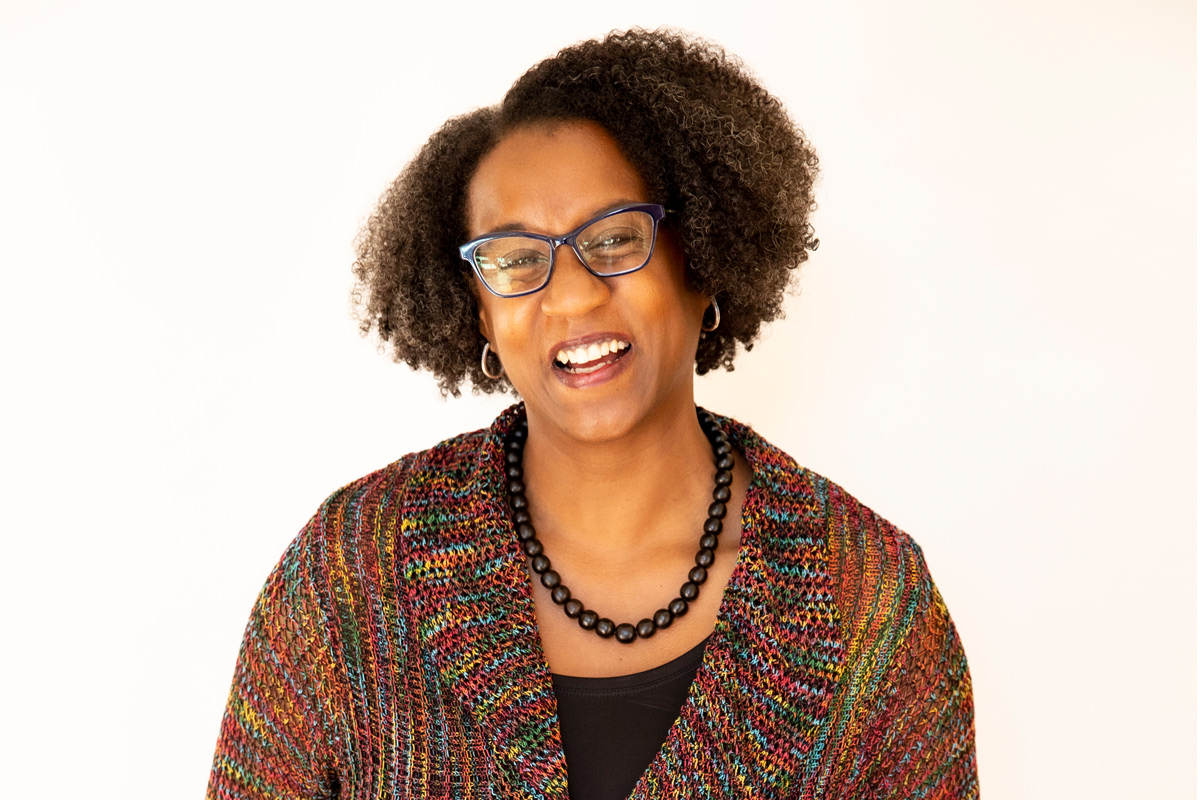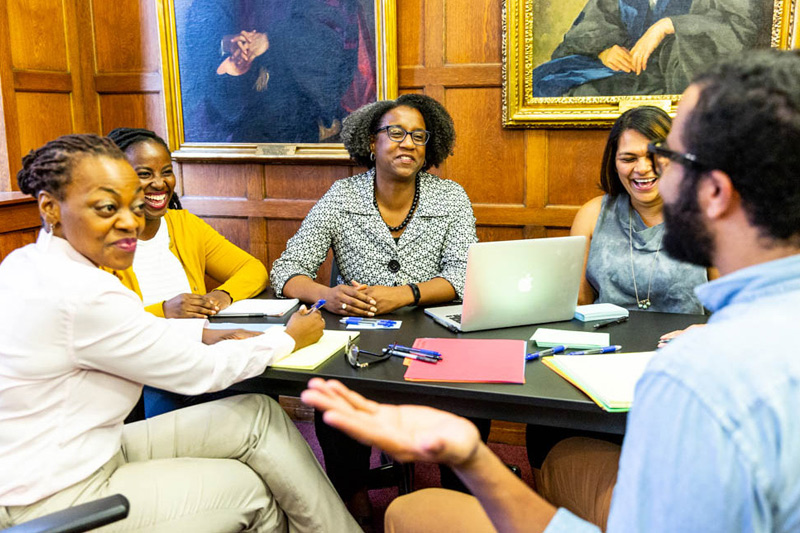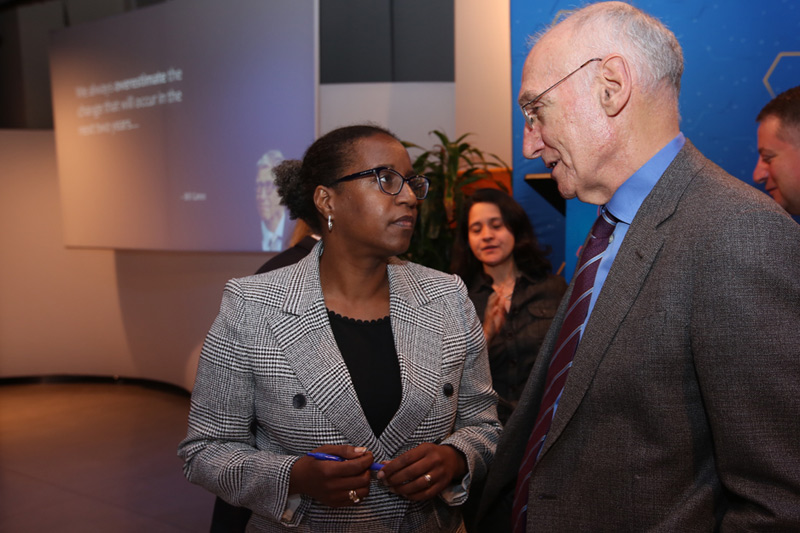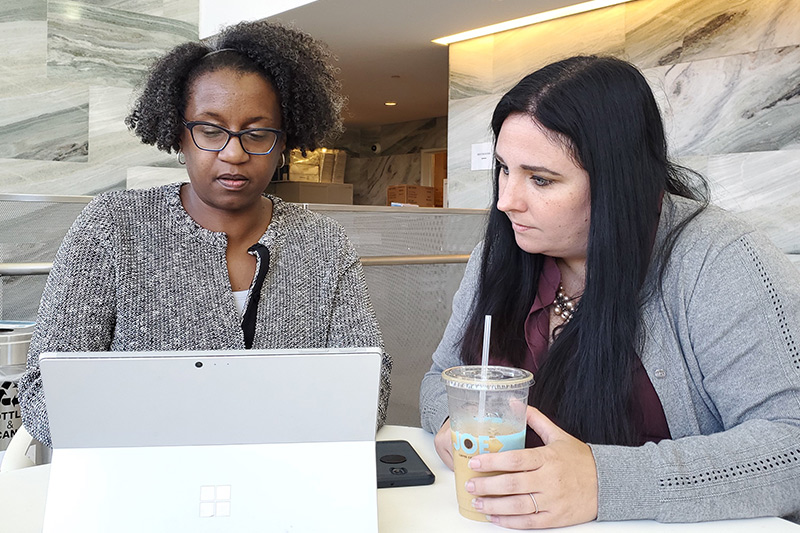Katie Schmitt offers two memories from her earliest days working with Stephanie Rowley at the University of Michigan: first, that Rowley encouraged her to think about her own professional development; and second, that whenever someone mentioned your staff, Rowley invariably responded by referring to my partners.
These were not mere gestures. As Rowley rose through U-M’s administrative ranks, Schmitt stayed with her, over time morphing into a trusted leader with input into shaping the Psychology & Education Department’s intellectual vision.
“Stephanie is a person who I share many values with,” says Schmitt. “She helped me recognize how much a leader shapes the culture of the workplace. And, in every position I’ve supported her in, we’ve landed someplace great.”
In July, Rowley left U-M (her alma mater) to become Teachers College’s new Provost, Dean and Vice President for Academic Affairs. In September, Schmitt followed as Director of Special Projects. “Stephanie contributed largely to my passion for academia,” she says. “She is a leader I believe in, and I’m proud to be standing next to her as she begins her tenure as Provost of Teachers College.”
Broadening the conversation
In Rowley’s career — as a teacher and mentor; as a social scientist exploring the formation of racial identity; as an administrator promoting interdisciplinary collaboration — creating conditions for others to succeed has been the leitmotif.
“Good leaders get you to buy into a vision, but great ones get you to co-create it,” says Robert Sellers, U-M’s Charles D. Moody Collegiate Professor of Psychology & Education, Vice Provost for Equity & Inclusion, and Chief Diversity Officer. “Besides being a special person who really cares about relationships, Stephanie is rare in being strategic and visionary, yet creating a collaborative, respectful and fun work environment.”
As with Schmitt, Rowley’s approach is to listen to people’s interests and needs, recognize their potential and, ultimately, change their sense of what’s possible. In one of her first administrative roles — as associate chair of U-M’s 100-member psychology department — she was tasked with increasing diversity and rejiggering office and lab space.
“Space is a sacred cow in academia, but she made the case for thinking about what the work really required,” Sellers says. “She listened to people’s fears and goals and earned their trust. That made her more effective in dealing with diversity.”
The experience served Rowley well when, in 2016, she became U-M’s Associate Vice President for Research. Her brief was to increase the traffic of social scientists and humanities faculty to an office which had mainly served engineers.
“We started out by saying, hey, we see you’re doing very different kinds of research and have different needs,” she recalled this past summer in her new office at TC. “Engineers are supported by a whole grant-writing infrastructure, but artists, say, usually work alone. So we collected examples of humanistic grants and developed workshops on how to get them.”
Sometimes people haven’t had great successes because, for example, no one taught them to write a grant. We want to build capacity for those who haven’t had opportunities.
—Stephanie Rowley
Those efforts paid off when a U-M project she helped facilitate called Mcity — a collaboration with automobile manufacturers to help develop autonomous vehicle technology — came up for renewal.
“The car makers had come to us because they wanted to avoid creating something people would be afraid to use or that would have terrible consequences after they’d sunk money into it,” Rowley says. “U-M not only had great engineers, but also psychologists, public health researchers, artists and others who could think through the impacts. But after five years, mostly engineering faculty were participating in the project.”
When Rowley asked other faculty why they weren’t participating, the answer was, essentially, “Oh, I didn’t think this was intended for me,” or “I didn’t see where I fit in.” She handpicked scholars from different fields to brainstorm about how to contribute.
“They raised fascinating questions. Would self-driving cars increase the transportation gulf between low-income and affluent people? What if wealthier people owned four different self-driving cars and sent them to do their shopping, or left them circling the block while they were in meetings?”
Nor did the input only raise red flags.
“One guy who was a transportation historian said that when people were switching from horses to automobiles, they had similar fears — ‘You want me to get in this thing where you can’t pull the reins?’ His point was that technology transitions are always difficult, but you can’t stop forward progress.”
Reframing the Narrative
Rowley’s focus on nurturing people’s potential seems to stem in part from being raised by two first-generation college students who emphasized the importance of interacting with all types of people.
“Our dinner table was always filled with guests from all walks of life,” she recalls. “My parents also taught us about how access to resources underlies variation in material success.”
In college at U-M, the summer after her freshman year, Rowley landed two work-study jobs at centers run, respectively, by the world-renowned developmental psychologists Vonnie McLoyd and Jacquelynne Eccles.
“My parents had said I could only stay in Ann Arbor for the summer if I supported myself,” she says. “I took those jobs because they paid the most, but I ended up staying in them through graduation.”
She was particularly influenced by McLoyd, whose work focuses on how poverty and economic hardship influence family life and parenting.
“There’s a whole narrative that low-income parents of color don’t have aspirations for their kids, but the big takeaway from Vonnie was that people try to manage the contexts they’re in,” Rowley says. “If you live in a dangerous neighborhood, if you’re afraid your kids might be shot by the police, if you’re simply trying to get enough food, your parenting may not always focus on algebra homework.”
Rowley’s unique contribution as a scholar has been to explore how black youth form a sense of racial identity; how that self-concept is shaped by narratives about them that teachers, parents and they themselves have created; and how racial identity affects their pursuit of education and a career.
Just putting resources in front of kids doesn’t do it. TC is on the front lines in training educators and thinking about principles of engagement in urban communities.
—Stephanie Rowley
In 1998, she was part of a group led by Robert Sellers that published the Multidimensional Model of Racial Identity (MMRI). Previously, white theorists had assumed that group identity looked the same across races or, for African Americans in a racist society, had negative consequences. In contrast, MMRI posits that African American racial identity reflects four key variables: salience, or the degree to which one consciously responds to a given situation as an African American; centrality, or how consistently one defines oneself as black regardless of context; regard, or how positively or negatively one feels about being black; and ideology, or one’s beliefs about the stance African Americans should take toward a white-dominated society.
Rowley has since mapped out how these dimensions operate in real life. Her approach, rooted in black people’s descriptions of their lived experiences, has simultaneously revealed, on the one hand, just how intensely African Americans feel the societal forces arrayed against them and, on the other, how those forces can make them complicit in perpetuating hurtful stereotypes.
In a 2014 chapter titled “Framing Black Boys: Parent, Teacher, and Student Narratives of the Academic Lives of Black Boys,” Rowley, her long-time collaborator, Beth Kurtz-Costes, a psychologist at the University of North Carolina at Chapel Hill, and others cite a litany of all-too-familiar statistics: Black boys are least likely among ethnic and gender groupings to earn a high school diploma in four years. They have the lowest standardized test scores and the highest rates of expulsion. They are most likely to be in special education classes or labeled as emotionally disturbed.
“Framing Black Boys” applies a “contextual analysis” paradigm to those numbers.
“If I think, ‘Poor kids don’t do well because they don’t value education,’ that doesn’t leave me many options for how to see myself if I’m poor,” Rowley says. “Whereas if I take up a more structural analysis of economic disparities, I might say, ‘Poor kids do less well in school because the system disenfranchises them.’”
Rowley, Kurtz-Costes et al. suggest reasons why black boys internalize society’s view. One is a cultural disconnect with white, female teachers, who often single them out early for discipline. The authors link this “adultification” of youthful behavior to the drop in black boys’ academic performance in fourth grade and argue it suggests a view of black boys as less innocent than other youngsters.
Black parents may also, unwittingly, feed the black boy narrative of low achievement. Concerned about discrimination and their sons’ grade-point averages and self-esteem, they may set lower expectations for boys than girls. Warning boys to expect unfair treatment may predispose them to distance themselves from school. In another paper, Rowley and her co-authors suggest that when black mothers act as watchdogs against discrimination, they may antagonize teachers, reinforcing a cycle of animosity that penalizes their children.
Yet Rowley and Kurtz-Costes also spotlight brighter narratives. A subset of New York City public schools graduates 80 percent of their low-income black and Latino boys. Black boys in five states are more likely to finish high school on time than their white counterparts. Nationwide, far more black boys qualify for advanced placement classes than take them — not a happy statistic, but confirmation that ability is not the issue.
“These data clearly demonstrate that, given the right conditions, Black boys can thrive academically,” Rowley and Kurtz-Costes write. Teachers must examine “their own histories, perspectives [and] beliefs [and] check their narratives about Black boys at the classroom door.” Black parents could focus more on academic goals and partnering with teachers and researchers on what is going right with black boys.
In a Different Space
When Katie Schmitt first read the description of the provost’s job at Teachers College, she told Rowley, “This was written for you.”
Certainly, Rowley was drawn by TC’s longstanding commitment to social justice and diversity. She’s eager to build on the College’s deep connections in Harlem and New York City in general.
Tom emphasized issues around diversity, equity and inclusion, and student experience. It was wonderfully un-presidential, in being concerned about individuals on the ground.
—Stephanie Rowley
“Racial and economic achievement gaps are largest in college towns, so just putting resources in front of kids doesn’t do it,” she says. “TC is on the front lines in training all kinds of educators and in thinking about the principles of engagement in urban communities.”
But equally important for Rowley, from the beginning, has been TC’s President, Thomas Bailey, and his mantra of creating “pathways to success” for all TC community members.
“Tom and the search committee really emphasized issues around diversity, equity and inclusion, and also student experience,” Rowley says. “It was wonderfully un-presidential, in the sense of being concerned about individuals on the ground. I thought, hey, we can accomplish things together.”
One of her priorities is to ensure that everyone gets the resources and mentoring they need.
“Sometimes people haven’t had great successes because, for example, no one taught them to write a grant. We want to build capacity for those who haven’t had opportunities,” she says.
She’s also determined to create more points of contact among TC’s faculty.
“The number of people and initiatives housed in this one city block is so impressive and important. How can we connect them more, and what are additional cross-cutting topics for collaboration?”
In July, Bailey introduced her at TC’s Edmund W. Gordon Lecture, delivered this year by urban education scholar Gloria Ladson-Billings.
Gordon, the 98-year-old psychologist and professor emeritus, would be honored afterward with an unveiling of his portrait.
The number of people and initiatives in this one city block is so impressive and important. How can we connect them more? What are additional cross-cutting topics for collaboration?
—Stephanie Rowley
“One of the very best things I have to announce today is that Stephanie Rowley has joined us at Teachers College,” Bailey said. “With her arrival, I have found a partner to lead TC — and especially in enabling everyone to succeed as we work toward creating comprehensive, evidence-based solutions to challenges in human development and well-being.”
Then Rowley stepped to the podium. “I couldn’t be more pleased that this is my first official activity at TC,” she said. She called Ladson-Billings “a giant in the field” and thanked Gordon for “mentoring a generation to think about black culture and its use for youth and schooling.
“I grew up, intellectually speaking, on his work. I learned that cultural difference isn’t deficiency. So, thank you, Dr. Gordon.”
She paused and smiled around at the crowd in Cowin Auditorium. “I am so happy to be here.”




